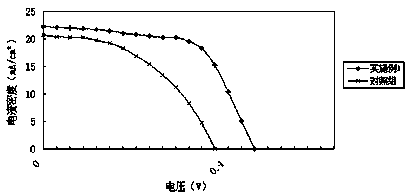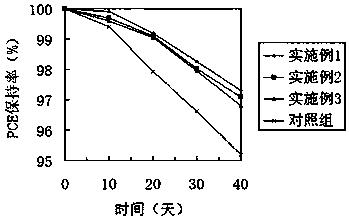Method for improving photoelectric conversion rate of two-dimensional perovskite solar cell
A technology for solar cells and photoelectric conversion rates, applied in circuits, photovoltaic power generation, electrical components, etc., can solve problems such as lower performance than three-dimensional perovskites, achieve the effects of reducing internal defects, reducing grain boundary area, and improving mobility
- Summary
- Abstract
- Description
- Claims
- Application Information
AI Technical Summary
Problems solved by technology
Method used
Image
Examples
Embodiment 1
[0021] A method for improving the photoelectric conversion rate of a two-dimensional perovskite solar cell, wherein the solar cell is as follows from bottom to top: FTO conductive glass layer, TiO2 dense layer, TiO2 mesoporous layer, perovskite layer, hole absorbing layer, Electrode layer; Wherein, described compact layer thickness is 40nm, TiO Mesoporous layer thickness is 400nm, hole transport layer thickness is 120nm, electrode layer thickness is 120nm; Perovskite layer is perovskite thin film, and thickness is 280nm;
[0022] Wherein, the square resistance of the FTO conductive glass is 14Ω / cm², and the transmittance is greater than 80%; the TiO2 dense layer is leached 3 times with diisopropoxydiacetylacetonate titanium ethanol solution with a concentration of 0.5mol / L , the leaching rate is 0.3mm / s, after each leaching is completed, let it stand for 10 minutes, and then dry it at 100°C for 20 minutes to obtain that; the TiO2 mesoporous layer is obtained by using titanium d...
Embodiment 2
[0031] A method for improving the photoelectric conversion rate of a two-dimensional perovskite solar cell, wherein the solar cell is as follows from bottom to top: FTO conductive glass layer, TiO2 dense layer, TiO2 mesoporous layer, perovskite layer, hole absorbing layer, Electrode layer; wherein, the thickness of the dense layer is 50nm, the TiO2 mesoporous layer thickness is 300nm, the hole transport layer thickness is 60nm, and the electrode layer thickness is 180nm; the perovskite layer is a perovskite film with a thickness of 220nm;
[0032] Wherein, the square resistance of the FTO conductive glass is 14Ω / cm², and the transmittance is greater than 80%; the TiO2 dense layer is leached 3 times with diisopropoxy diacetylacetonate titanium ethanol solution with a concentration of 0.6mol / L , the leaching rate is 0.3mm / s, after each leaching is completed, let it stand for 10 minutes, and then dry it at 100°C for 20 minutes to obtain that; the TiO2 mesoporous layer is obtained ...
Embodiment 3
[0041] A method for improving the photoelectric conversion rate of a two-dimensional perovskite solar cell, wherein the solar cell is as follows from bottom to top: FTO conductive glass layer, TiO2 dense layer, TiO2 mesoporous layer, perovskite layer, hole absorbing layer, Electrode layer; wherein, the thickness of the dense layer is 30nm, the TiO2 mesoporous layer thickness is 500nm, the hole transport layer thickness is 180nm, and the electrode layer thickness is 60nm; the perovskite layer is a perovskite film with a thickness of 320nm;
[0042] Wherein, the square resistance of the FTO conductive glass is 14Ω / cm², and the transmittance is greater than 80%; the TiO2 dense layer is leached 3 times with diisopropoxydiacetylacetonate titanium ethanol solution with a concentration of 0.4mol / L , the leaching rate is 0.3mm / s, after each leaching is completed, let it stand for 10 minutes, and then dry it at 100°C for 20 minutes to obtain that; the TiO2 mesoporous layer is obtained b...
PUM
| Property | Measurement | Unit |
|---|---|---|
| thickness | aaaaa | aaaaa |
| thickness | aaaaa | aaaaa |
| thickness | aaaaa | aaaaa |
Abstract
Description
Claims
Application Information
 Login to View More
Login to View More - R&D
- Intellectual Property
- Life Sciences
- Materials
- Tech Scout
- Unparalleled Data Quality
- Higher Quality Content
- 60% Fewer Hallucinations
Browse by: Latest US Patents, China's latest patents, Technical Efficacy Thesaurus, Application Domain, Technology Topic, Popular Technical Reports.
© 2025 PatSnap. All rights reserved.Legal|Privacy policy|Modern Slavery Act Transparency Statement|Sitemap|About US| Contact US: help@patsnap.com


